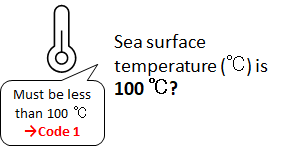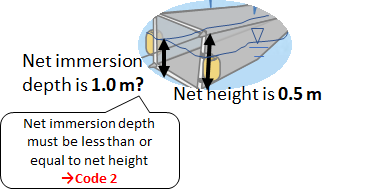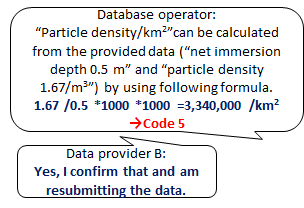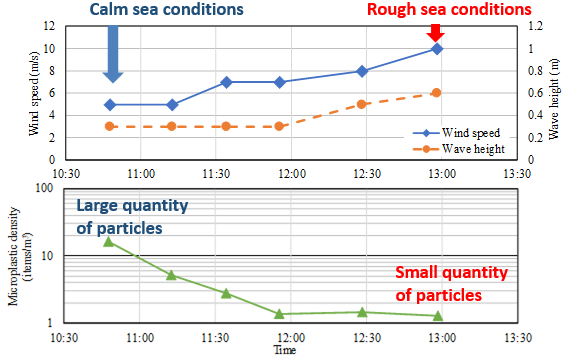REFERENCES
Related Guidelines and Papers
Related Guidelines:
- The guidelines include the requirements for sampling and analysis to obtain comparable data on ocean surface microplastics as scientific findings, which serve as the base for taking globally coordinated actions.
- The guidelines were developed by experts from different countries after the reviews of different existing guidelines, lab experiments, and demonstration projects using research vessels.
- The standard Data Entry Form recommended by AOMI includes all data items for registration recommended by the guidelines. The data stored in AOMI are quality-controlled according to the guidelines. See TOPIC 2 below for details. Click here for more
Guidelines for Harmonizing Ocean Surface Microplastic Monitoring Methods
Papers:
- An article by Atsuhiko Isobe et al. published in Microplastics and Nanoplastics.
- In addition to original uncorrected data, AOMI stores data corrected by the method discussed in this article (i.e., processed Levels 1, 2, and 3) to provide for users. Particularly, particle density maps created based on processed level 3 data are provided as synthesized products scientifically corrected for effects of the uneven distribution of survey points. See TOPICS 2 and 3 below for details. Click here for more
A multilevel dataset of microplastic abundance in the world's upper ocean and the Laurentian Great Lakes
Explanatory Materials
List of Explanatory Materials:
TOPIC 1: Terms used TOPIC 2: Quality Control and Data Processing TOPIC 3: Data Processing Methods TOPIC 4: Contents of data available for viewingTOPIC 1: Terms used
1. Overview
List of terms that describe data stored in AOMI. Similar descriptions are included in the standard Data Entry Form.
Click here for moreTOPIC 2: Quality Control and Data Processing
1. Overview of Quality Control and Data Processing
Quality control and data processing are conducted by Database Administrators for the benefit of Database Users. The box on the right provides an overview of the methods involved.
2. Quality Control Codes
First, the database administrator checks all the data records and assigns a QC code to each item, as presented in Table 1.
Table1 Outline of QC codes.
| QC Code | Meaning of Code |
|---|---|
| 0 | No errors |
| 1 | Logically improbable value |
| 2 | Values showing inconsistency between data |
| 3 | Deviated value compared to other existing data (values that have not been checked with the data provider) |
| 4 | Deviated value compared to other existing data (checked with the data provider and value confirmed as an outlier) |
| 5 | Value added by the database administrator after converting units from provided data only |
| 6 | Value possible for the data provider to add from other data items |
- If there are suspected QC Code 3 data items, the database administrator shall consult experts on how to address them appropriately.
- For data records with QC Code 1, 2, 3, 5, or 6 data items, the database administrator shall, in principle, requests the data provider to confirm, add, or correct the data to achieve QC Code 0, to the possible extent.
- For data items that remain as QC Code 3 even after confirmation and correction by the data provider, the database administrator shall change the QC code from 3 to 4.
3. Quality Control Grades
Quality-controlled data (QC Grade 2 or higher) are presented in the database.
A QC grade, which indicates the accuracy of the data, is assigned in accordance with the description of each grade as presented in Table 2.
Collecting and storing "harmonized data" would be ideal; however, faultless datasets are rare. This database provides QC grade information on the extent of harmonization of each dataset, allowing database users to select datasets at their discretion to achieve their goals.
Table 2 Outline of QC grades.
| QC Grade | Description of QC Grade |
|---|---|
| 1 | Data received (no quality control) |
| 2 | Data with codes for quality control |
| 3 | Data include "fundamental data items" |
| 4 | Data include all "essential data items" |
| 5 | Harmonized data* |
*1: Fundamental data items: minimum requirements to identify the abundance of microplastics, sampling time and location, and microplastic density, which can be displayed in any of the following four units: quantity of particles/m³ or km² and weight/m³ or km².
*2: Essential data items: minimum requirements to make the survey results comparable.
*3: Harmonized data: data within a comparable range of essential data items.
For more information on the "fundamental data items," "essential data items," and "harmonized data," please refer to Guidelines for Harmonizing Ocean Surface Microplastic Monitoring Methods.
4. Data Processing
The abundance of ocean surface microplastics varies considerably, even in the same position, depending on the meteorological and oceanographic conditions at the time of measurement. "Data processing" with calculations and simulations can be means of creating approximate 2D maps efficiently by eliminating temporal fluctuations and uneven particle distributions.
In this database, the database administrator has corrected the quality-controlled data set (original data set; refer to "1. Overview of Quality Control and Data Processing") and compiled it as a "processed data set" based on the latest scientific findings (Isobe et al., 2021). This section outlines the data processing method.
5. Outline of Processed Data
The processed data are classified as Processed Levels 1, 2, and 3, depending on the degree of data correction. The higher the processing level, the more advanced the corrections applied (see Table 3).
Table 3 Outline of processed data.
| Processed Level 1 | Calibration by removal of fibrous microplastics (particles/m³) |
| Processed Level 2 | Processing for wind/wave correction (particles/km²) and conversion from particle count to weight (g/km²) |
| Processed Level 3 | Data gridded using an optimum interpolation method (OEM) (particles/km², g/km²) |
(1) Data Processing (level 1)
Particle density varies depending on the monitoring method. The inclusion or exclusion of fibrous microplastics significantly affects particle density results. Level 1 particle density should be obtained by multiplying the particle density of the original particles by the particle quantity ratio (excluding fibrous microplastics).
(2) Data Processing (level 2)
Processed Level 2 is obtained by "processing for wind/wave correction" and "converting from particle count to weight" for Processed Level 1 data.
1) Wind wave correction processing
In principle, the total amount of microplastics contained in the water column (from the ocean surface to the seafloor) should not change regardless of sea conditions. However, particles accumulate in the surface layer under calm conditions, while they disperse throughout the lower and upper layers under rough conditions owing to vertical mixing. Thus, the quantity of particles obtained from field surveys is affected by sea conditions. It becomes possible to estimate the amount of microplastics in the water column by vertically integrating from the sea surface to the seafloor.
2) Conversion from particle count to weight
Isobe et al. (2021) proposed two methods for converting particle counts to weights.
(a) High-weight estimation
High-weight estimation converts the particle count to weight based on the unit weight (0.0237 g/particle) obtained by Isobe et al. (2019) for the South and West Pacific Oceans. The relationship between the particle quantity density and particle weight density (W) in the particle size range (δ) from 0.3 mm to 5 mm is as follows:
W (g/km²) = 0.0237 M (particles/km²)
(b) Low-weight estimation
Low-weight estimation is a method for converting the particle count to weight based on the unit weight, as determined by Cózar et al. (2019) for the Mediterranean Sea. The following approximate formula was converted from particle quantity density (M, particles/km²) to particle weight density (W, g/km²):
log10 W (g/km²) = 1.22 log10 M (particles/km²) - 4.04
(3) Data Processing (level 3)
Processed Level 3 are obtained from Processed Level 2 data, which are spatially gridded in a 2-degree-latitude by 5-degree-longitude grid.
6. More Information
- Data check/quality control manual
- Data processing manual
- Guidelines for Harmonizing Ocean Surface Microplastic Monitoring Methods
- Atsuhiko Isobe, Takafumi Azuma, Muhammad Reza Cordova, Andrés Cózar, Francois Galgani, Ryuichi Hagita, La Daana Kanhai, Keiri Imai, Shinsuke Iwasaki, Shin'ichro Kako, Nikolai Kozlovskii, Amy L. Lusher, Sherri A. Mason, Yutaka Michida, Takahisa Mituhasi, Yasuhiro Morii, Tohru Mukai, Anna Popova, Kenichi Shimizu, Tadashi Tokai, Keiichi Uchida, Mitsuharu Yagi and Weiwei Zhang (2021) A multilevel dataset of microplastic abundance in the world's upper ocean and Laurentian Great Lakes. Microplastics and Nanoplastics 1, 16.
Guidelines web page:
http://www.env.go.jp/en/water/marine_litter/guidelines/guidelines.pdf
Manuals web page:
TOPIC 3: Data Processing Methods
1. Introduction
Levels 1 to 3 of the processed datasets registered in this database comprise two types of datasets: one compiled by Isobe et al., (2021)*1 and a newly created dataset that was applied to the original dataset (Processed Level 0) using the method of Isobe et al. (2021)
*1:Atsuhiko Isobe, Takafumi Azuma, Muhammad Reza Cordova, Andrés Cózar, Francois Galgani, Ryuichi Hagita, La Daana Kanhai, Keiri Imai, Shinsuke Iwasaki, Shin'ichro Kako, Nikolai Kozlovskii, Amy L. Lusher, Sherri A. Mason, Yutaka Michida, Takahisa Mituhasi, Yasuhiro Morii, Tohru Mukai, Anna Popova, Kenichi Shimizu, Tadashi Tokai, Keiichi Uchida, Mitsuharu Yagi and Weiwei Zhang (2021) A multilevel dataset of microplastic abundance in the world's upper ocean and the Laurentian Great Lakes. Microplastics and Nanoplastics, 1, 16.
2. Overview of Processing Data
An overview of processing of data to be registered in the database is presented in Table 1.
For the Processed Level 2 data, two types of datasets will be registered by converting particle number density to particle weight density for high and low estimates.
Table 1 Overview of data processing.
| Processed Level 1 | Calibration by removal of fibrous microplastics (particles/m³) |
| Processed Level 2 | Processing for wind/wave correction (particles/km²) and conversion from particle count to weight (g/km²) |
| Processed Level 3 | Data gridded through an optimum interpolation method (OEM) (particles/km² , g/km²) |
3. Data Processing Methods
(1) Level 0 (raw data)
Data are obtained based on harmonized methods (Michida et al., 2020)*2 using the following procedure:
- Based on the assumption that any terms after 2000 would be too short to detect long-term changes in suspended solids, only data obtained after year 2000 was collected.
- Towed net surveys and surface sampling (engine cooling water) were conducted at depths shallower than 3 m below sea surface.
- For towed net surveys the mesh size of the net must be approximately 0.2–0.3 mm.
- In principle, for towing surveys, the filtered seawater volume is measured using a flow meter, with the exception of cases where large amounts of data are obtained, as in Law et al., (2014)*3.
-In principle, original data of less than 5 mm particle size with the density unit of particles/m³ is calibrated.
-If the reported unit is particles/km² only and the sampling depth is unknown, sampling should be conducted with the upper end of the Neuston net kept at the sea surface. To convert the unit into particles/m³, assume that the submerged height is 1/2 of the net height.
-If the obtained data are given in terms of weight density (g/km³ or g/km²) only, they should be converted to particle density, referencing the conversion from particle count to Level 2 weight.
*2:Yutaka Michida, Suchana Chavanich, Sanae Chiba, Muhammad Reza Cordova, Andrés Cózar Cabañans, Francois Galgani, Pascal Hagmann, Hirofumi Hinata, Atsuhiko Isobe, Peter Kershaw, Nikolai Kozlovskii, Daoji Li, Amy L. Lusher, Elisa Martí, Sherri A. Mason , Jingli Mu, Hiroaki Saito, Won Joon Shim, Agung Dhamar Syakti , Hideshige Takada, Richard Thompson, Tadashi Tokai, Keiichi Uchida, Katerina Vasilenko and Juying Wang,(2020) Guidelines for harmonizing ocean surface microplastic monitoring methods. Ministry of Environ Japan.
*3:Kara Lavender Law, Skye E. Morét-Ferguson, Deborah S. Goodwin, Erik R. Zettler, Emelia DeForce, Tobias Kukulka, and Giora Proskurowski (2014) Distribution of Surface Plastic Debris in the Eastern Pacific Ocean from an 11-Year Data Set. Environmental Science & Technology, 48(9):4732–8.
(2) Processed Level 1.
The original dataset is corrected to Processed Level 1 datasets by removing fibers according to the following method:
-The level 1 particle density is obtained by multiplying the particle density of the original particles by the particle number ratio (excluding fibrous microplastics).
-The original data ratio without fibrous microplastics is considered 100% because the ratio of these data to the overall microplastic load appears to be small, especially in the open ocean.
(3) Processed Level 2.
1) Processing for wind/wave correction
Level 1 data (numbers) are revised to the area particle number density (M, particles/km²) by integrating from the sea surface to the bottom, as shown below:
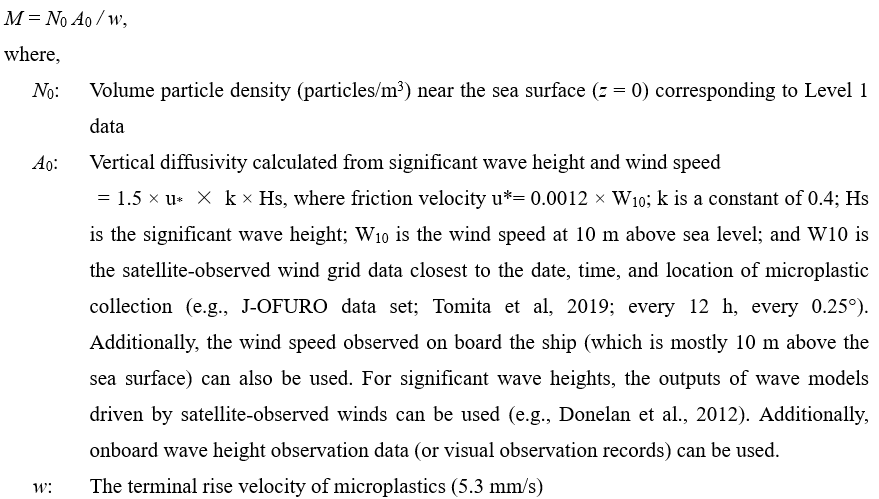
2) Conversion from particle count to weight
(a) High-level estimates.
High-level estimates use the method proposed by Isobe et al. (2019)*4 based on their study conducted in the South and West Pacific Ocean.
The data should be converted based on the following assumption:

*4:Isobe A, Iwasaki S, Uchida K, Tokai T. (2019) Abundance of non-conservative microplastics in the upper ocean from 1957 to 2066. Nat. Comm.,10: 417.
(b) Low-level estimates.
Low-level estimates use the method provided by Cózar et al. (2019)*5 in their study conducted in the Mediterranean Sea.The conversion from particle number density (M, particles/km² ) to particle weight density (W, g/km² ) is calculated using the approximate formula of Eq. 2-4 derived from the survey results.

*5:Cózar A, Echevarría F, González-Gordillo JI, Irigoien X, Úbeda B, Hernández-León S, et al. (2014) Plastic debris in the open ocean. Proc Natl Acad Sci., 111(28):10239-44.
(4) Processed Level 3.
Each grid density is obtained based on the following equation from the Processed Level 2 data to achieve the lowest error. The following optimal interpolation algorithms follow Daley (1991) and Kako et al. (2011):

The optimum weight is computed such that the errors included in the observed (O) and first-guess (B) values in Eq. 3-1 will be unbiased and uncorrelated to generate gridded data free of biases and can be expressed as Eq. 3-2.
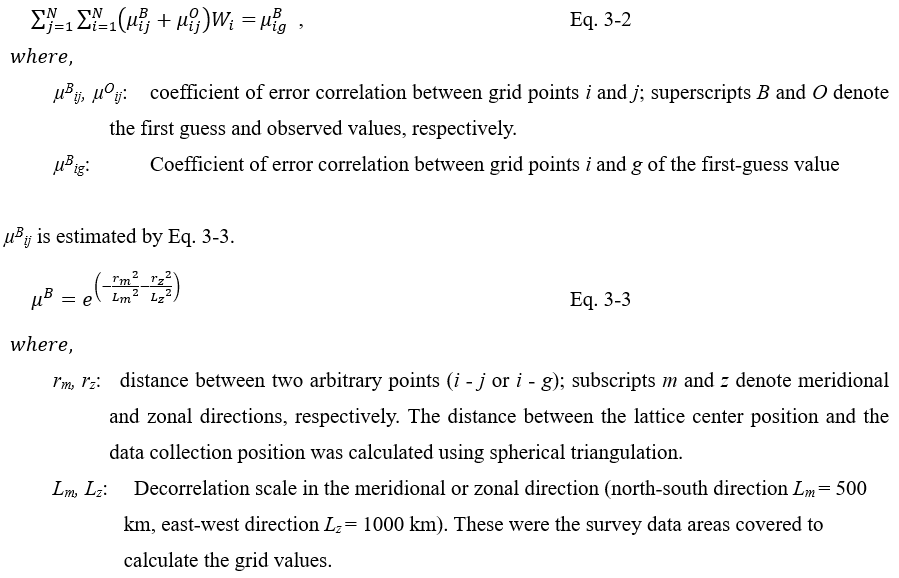
Note that interpolation is not conducted for grid cells fewer than the observed data points within the decorrelation scales. If the grid value is negative, data are considered missing.
Tomita H., Hihara T., Kako S., Kubota M., Kutsuwada K. (2019) An introduction to JOFURO3, a third-generation Japanese ocean flux data set using remote-sensing observations. J. Oceanogr., 75(2):171–94
Kako S., Isobe A., Kubota M. (2011) High-resolution ASCAT wind vector data set gridded by applying an optimum interpolation method to the global ocean. J. Geophys. Res. Atmos., 116: D23107.
Daley R. Atmospheric data analysis: Cambridge University Press; 1991.
Donelan M.A., Curcic M., Chen S.S., Magnusson A.F. (2012) Modelling waves and wind stress. J Geophys. Res. C-Oceans, 117:C00J23.
TOPIC 4: Contents of data available for viewing
1. Dataset stored in AOMI
More than 13,000 data records from 50 different data sets are available in AOMI.
| No. | Number of records |
Contributor (First author) | Reference |
|---|---|---|---|
| 1 | 194 | Andres Cozar Cabanas | Andres Cozar, Fidel Echevarria, J. Ignacio Gonzalez-Gordillo, Xabier Irigoien, Barbara Ubeda, Santiago Hernandez-Leon, Alvaro T. Palmae, Sandra Navarro, Juan Garcia-de-Lomas, Andrea Ruiz, Maria L. Fernandez-de-Puelles, Carlos M. Duarte, (2014). Plastic debris in the open ocean., Proceedings of the National Academy of Sciences,111(28), 10239-10244. |
| 2 | 39 | Andres Cozar Cabanas | Andres Cozar, Marina Sanz-Martin, Elisa Marti, J. Ignacio Gonzalez-Gordillo, Barbara Ubeda, Jose A. Galvez, Xabier Irigoien, Carlos M. Duarte (2015). Plastic accumulation in the Mediterranean Sea., PloS one, 10(4). |
| 3 | 43 | Andres Cozar Cabanas | Andres Cozar, Elisa Marti, Carlos M. Duarte, Juan Garcia-de-Lomas, Erik van Sebille, Thomas J. Ballatore, Victor M. Eguiluz, J. Ignacio Gonzalez-Gordillo, Maria L. Pedrotti, Fidel Echevarria, Romain Trouble, Xabier Irigoien (2017). The Arctic Ocean as a dead end for floating plastics in the North Atlantic branch of the Thermohaline Circulation. Science advances, 3(4), e1600582. |
| 4 | 74 | Giuseppe Suaria | Suaria, G., Avio, C. G., Mineo, A., Lattin, G. L., Magaldi, M. G., Belmonte, G., ... & Aliani, S. (2016). The Mediterranean Plastic Soup: synthetic polymers in Mediterranean surface waters. Scientific reports, 6, 37551. |
| 5 | 11 | Zhang Weiwei | Zhang W, Zhang S, Wang J, Wang Y, Mu J, Wang P, et al. Microplastic pollution in the surface waters of the Bohai Sea, China. Environ Pollut. 2017;231(Pt 1):541–8. |
| 6 | 15 | Shiye Zhao | Shiye Zhao, Lixin Zhu, Teng Wang, Daoji Li, (2014) Suspended microplastics in the surface water of the Yangtze Estuary System, China: First observations on occurrence, distribution., Marine Pollution Bulletin, 86, 562-568 |
| 7 | 130 | Sherri A. Mason | Sherri A.Mason, Juliette Daily, Ghadah Aleid, Rachel Ricotta, Morgan Smith, Katie Donnelly, Rebecca Knauff, William Edwards, Matthew J.Hoffman, (2020), High levels of pelagic plastic pollution within the surface waters of Lakes Erie and Ontario, Journal of Great Lakes Research, |
| 8 | 16 | Muhammad Reza Cordova | Monitoring data in Indonesia provided by Indonesian Institute of Sciences (Not published) |
| 9 | 256 | Francois Galgani | MSFD National Data (Not published) |
| 10 | 21 | Kozlovskii Nikolai | Monitoring data in Russian Federation provided by Pacific Geographical Institute FEB RAS (Not published) |
| 11 | 216 | Keiichi Uchida | Michida, Y., Chavanich, S., Chiba, S., Cordova, M. R., Cozsar Cabanas, A., Glagani, F., ... & Wang, J. (2019). Guidelines for Harmonizing Ocean Surface Microplastic Monitoring Methods. Version 1.1. |
| 12 | 83 | Argyro Adamopoulou | Adamopoulou, A., Zeri, C., Garaventa, F., Gambardella, C., Ioakeimidis, C., & Pitta, E. (2021). Distribution Patterns of Floating Microplastics in Open and Coastal Waters of the Eastern Mediterranean Sea (Ionian, Aegean, and Levantine Seas). Frontiers in Marine Science, 1235. |
| 13 | 398 | Marie Russell | Russell, M., & Webster, L. (2021). Microplastics in sea surface waters around Scotland. Marine Pollution Bulletin, 166, 112210. |
| 14 | 7 | Ministry of the Environment Government of Japan | Sanyo Tecno Marine inc. (2015), 2014 Research report on marine debris floating on the ocean surface and settled on the sea bed in coastal areas around Japan |
| 15 | 20 | Ministry of the Environment Government of Japan | Universe Co.,Ltd. (2016), 2015 Research report on marine debris floating on the ocean surface and settled on the sea bed in coastal areas around Japan |
| 16 | 6 | Ministry of the Environment Government of Japan | Naigai Map Production inc. (2016), 2015 Research report on marine debris floating on the ocean surface in Setonaikai |
| 17 | 11 | Ministry of the Environment Government of Japan | Sanyo Tecno Marine inc. (2017), 2016 Research report on marine debris floating on the ocean surface and settled on the sea bed in coastal areas around Japan |
| 18 | 9 | Ministry of the Environment Government of Japan | Sanyo Tecno Marine inc. (2018), 2017 Research report on marine debris floating on the ocean surface and settled on the sea bed in coastal areas around Japan |
| 19 | 184 | Ministry of the Environment Government of Japan | Marine environment monitoring survey, MOEJ |
| 20 | 30 | Ministry of the Environment Government of Japan | Nihonkai environmental service Inc. et al., Fy2020 report on the survey of floating debris including microplastics in coastal waters, March 2021 |
| 21 | 60 | Ministry of the Environment Government of Japan | Nihonkai environmental service Inc. et al., Fy2021 report on the survey of floating debris including microplastics in coastal waters, March 2022 |
| 22 | 21 | William P. de Haan | de Haan, W. P., Sanchez-Vidal, A., Canals, M., & Party, N. S. S. (2019). Floating microplastics and aggregate formation in the Western Mediterranean Sea. Marine pollution bulletin, 140, 523-535. |
| 23 | 56 | Xia Zhu | Zhu, X., Munno, K., Grbic, J., Werbowski, L. M., Bikker, J., Ho, A., ... & Rochman, C. (2021). Holistic Assessment of Microplastics and Other Anthropogenic Microdebris in an Urban Bay Sheds Light on Their Sources and Fate. ACS ES&T Water. |
| 24 | 40 | Giuseppe Suaria | Suaria, G., Perold, V., Lee, J. R., Lebouard, F., Aliani, S., & Ryan, P. G. (2020). Floating macro-and microplastics around the Southern Ocean: Results from the Antarctic Circumnavigation Expedition. Environment international, 136, 105494. |
| 25 | 48 | Evgeniy Yakushev | Yakushev, E., Gebruk, A., Osadchiev, A., Pakhomova, S., Lusher, A., Berezina, A., ... & Semiletov, I. (2021). Microplastics distribution in the Eurasian Arctic is affected by Atlantic waters and Siberian rivers. Communications Earth & Environment, 2(1), 1-10. |
| 26 | 54 | Matthias Egger | Egger, M., Quiros, L., Leone, G., Ferrari, F., Boerger, C. M., & Tishler, M. (2021). Relative abundance of floating plastic debris and neuston in the eastern North Pacific Ocean. Frontiers in Marine Science, 8, 566. |
| 27 | 2527 | Law Kara Lavender | Law, K. L., Moret-Ferguson, S. E., Goodwin, D. S., Zettler, E. R., DeForce, E., Kukulka, T., & Proskurowski, G. (2014). Distribution of surface plastic debris in the eastern Pacific Ocean from an 11-year data set., Environmental science & technology,48(9), 4732-4738. |
| 28 | 5809 | Law Kara Lavender | Law, K. L., Morét-Ferguson, S., Maximenko, N. A., Proskurowski, G., Peacock, E. E., Hafner, J., & Reddy, C. M. (2010). Plastic accumulation in the North Atlantic subtropical gyre. Science, 329(5996), 1185-1188. |
| 29 | 76 | Rei Yamashita | Yamashita, R., & Tanimura, A. (2007). Floating plastic in the Kuroshio current area, western North Pacific Ocean. Marine Pollution Bulletin, 4(54), 485-488. |
| 30 | 128 | ISOBE Atsuhiko | Atsuhiko Isobe, Takafumi Azuma, Muhammad Reza Cordova, Andrés Cózar, Francois Galgani, Ryuichi Hagita, La Daana Kanhai, Keiri Imai, Shinsuke Iwasaki, Shin'ichro Kako, Nikolai Kozlovskii, Amy L. Lusher, Sherri A. Mason, Yutaka Michida, Takahisa Mituhasi, Yasuhiro Morii, Tohru Mukai, Anna Popova, Kenichi Shimizu, Tadashi Tokai, Keiichi Uchida, Mitsuharu Yagi, Weiwei Zhang, (2021). A multilevel dataset of microplastic abundance in the world's upper ocean and the Laurentian Great Lakes. Microplastics and Nanoplastics 1, 16 |
| 31 | 10 | Haruka Nakano | Nakano, H., Arakawa, H., & Tokai, T. (2021). Microplastics on the sea surface of the semi-closed Tokyo Bay. Marine Pollution Bulletin, 162, 111887. |
| 32 | 10 | Suchana Chavanich | Unpublished |
| 33 | 271 | Miriam J. Doyle | Doyle, M. J., Watson, W., Bowlin, N. M., & Sheavly, S. B. (2011). Plastic particles in coastal pelagic ecosystems of the Northeast Pacific ocean. Marine Environmental Research, 71(1), 41-52. |
| 34 | 147 | Miriam C. Goldstein | Goldstein, M. C., Titmus, A. J., & Ford, M. (2013). Scales of spatial heterogeneity of plastic marine debris in the northeast Pacific Ocean., PloS one, 8(11). |
| 35 | 10 | Giuseppe Andrea de Lucia | de Lucia, G. A., Caliani, I., Marra, S., Camedda, A., Coppa, S., Alcaro, L., ... & Panti, C. (2014). Amount and distribution of neustonic micro-plastic off the western Sardinian coast (Central-Western Mediterranean Sea)., Marine Environmental Research, 100, 10-16. |
| 36 | 651 | Amy L. Lusher | Lusher AL, Burke A, O'Connor I, Officer R. Microplastic pollution in the Northeast Atlantic Ocean: validated and opportunistic sampling. Mar Pollut Bull. 2014;88(1-2):325–33. |
| 37 | 22 | Amy L. Lusher | Lusher, A. L., Tirelli, V., O'Connor, I., & Officer, R. (2015). Microplastics in Arctic polar waters: the first reported values of particles in surface and sub-surface samples. Scientific reports, 5, 14948. |
| 38 | 57 | Julia Reisser | Julia Reisser, Jeremy Shaw, Chris Wilcox, Britta Denise Hardesty, Maira Proietti, Michele Thums, Charitha Pattiaratchi, (2013). Marine plastic pollution in waters around Australia: characteristics, concentrations, and pathways., PloS one, 8(11). |
| 39 | 37 | Amandine Collignon | Amandine Collignon, Jean-Henri Hecq, Francois Galgani, France Collard, Anne Goffart. (2014). Annual variation in neustonic micro-and meso-plastic particles and zooplankton in the Bay of Calvi (Mediterranean-Corsica). Marine Pollution Bulletin,79(1-2), 293-298. |
| 40 | 17 | Tamara Gajšt | Gajšt, T., Bizjak, T., Palatinus, A., Liubartseva, S., & Kržan, A. (2016). Sea surface microplastics in Slovenian part of the Northern Adriatic. Marine pollution bulletin, 113(1-2), 392-399. |
| 41 | 33 | Kinsley McEachern | McEachern, K., Alegria, H., Kalagher, A. L., Hansen, C., Morrison, S., & Hastings, D. (2019). Microplastics in Tampa Bay, Florida: Abundance and variability in estuarine waters and sediments. Marine pollution bulletin, 148, 97-106. |
| 42 | 24 | Ulgen Aytan | Aytan, U., Valente, A., Senturk, Y., Usta, R., Sahin, F. B. E., Mazlum, R. E., & Agirbas, E. (2016). First evaluation of neustonic microplastics in Black Sea waters. Marine environmental research, 119, 22-30. |
| 43 | 12 | Adil Bakir | Bakir, A., Desender, M., Wilkinson, T., Van Hoytema, N., Amos, R., Airahui, S., ... & Maes, T. (2020). Occurrence and abundance of meso and microplastics in sediment, surface waters, and marine biota from the South Pacific region. Marine Pollution Bulletin, 160, 111572. |
| 44 | 11 | Kirstie Jones-Williams | Jones-Williams, K., Galloway, T., Cole, M., Stowasser, G., Waluda, C., & Manno, C. (2020). Close encounters-microplastic availability to pelagic amphipods in sub-antarctic and antarctic surface waters. Environment International, 140, 105792. |
| 45 | 192 | Lisa R Gilfillan | Gilfillan, L. (2009). Occurrence of plastic micro-debris in the California current system. |
| 46 | 18 | Zhong Pan | Zhong Pan, Huige Guo, Hongzhe Chen, SuminWang, Xiuwu Sun, Qingping Zou, Yuanbiao Zhang, Hui Lin, Shangzhan Cai, Jiang Huang. (2019). Microplastics in the Northwestern Pacific: Abundance, distribution, and characteristics, Science of the Total Environment, 650, 1913-1922. |
| 47 | 33 | Maria Luiza Pedrotti | Maria Luiza Pedrotti, Stéphanie Petit, Amanda Elineau, Stéphane Bruzaud, Jean-Claude Crebassa, Bruno Dumontet, Elisa Martí, Gabriel Gorsky, Andrés Cózar. (2016). Changes in the floating plastic pollution of the Mediterranean Sea in relation to the distance to land., PloS one, 11(8). |
| 48 | 20 | Ministry of the Environment Government of Japan | Naigai Map Production inc. (2019), 2018 Research report on marine debris floating on the ocean surface and settled on the sea bed in coastal areas around Japan |
| 49 | 18 | Ministry of the Environment Government of Japan | Sanyo Tecno Marine inc. (2020), 2019 Research report on marine debris floating on the ocean surface and settled on the sea bed in coastal areas around Japan |
| 50 | 58 | Keiichi Uchida | Tokyo University of Marine Science and Technology (2015), FY2014 Report of Study on the Distribution of Ocean Surface and Bottom Litter in Offshore. |
| 51 | 78 | Keiichi Uchida | Tokyo University of Marine Science and Technology (2016), FY2015 Report of Study on the Distribution of Ocean Surface and Bottom Litter in Offshore. |
| 52 | 117 | Keiichi Uchida | Tokyo University of Marine Science and Technology (2017), FY2016 Report of Study on the Distribution of Ocean Surface and Bottom Litter in Offshore. |
| 53 | 146 | Keiichi Uchida | Tokyo University of Marine Science and Technology (2018), FY2017 Report of Study on the Distribution of Ocean Surface and Bottom Litter in Offshore. |
| 54 | 175 | Keiichi Uchida | Tokyo University of Marine Science and Technology (2019), FY2018 Report of Study on the Distribution of Ocean Surface and Bottom Litter in Offshore. |
| 55 | 679 | Eriksen Marcus | Eriksen M, Lebreton LCM, Carson HS, Thiel M, Moore CJ, Borerro JC, et al. Plastic pollution in the world’s oceans: more than 5 trillion plastic pieces weighing over 250,000 tons afloat at sea. PLoS One. 2014;9(12):e111913 |
| 56 | 106 | Isobe Astuhiko | Atsuhiko Isobe, Takafumi Azuma, Muhammad Reza Cordova, Andrés Cózar, Francois Galgani, Ryuichi Hagita, La Daana Kanhai, Keiri Imai, Shinsuke Iwasaki, Shin’ichro Kako, Nikolai Kozlovskii, Amy L. Lusher, Sherri A. Mason, Yutaka Michida, Takahisa Mituhasi, Yasuhiro Morii, Tohru Mukai, Anna Popova, Kenichi Shimizu, Tadashi Tokai, Keiichi Uchida, Mitsuharu Yagi, Weiwei Zhang, (2021). A multilevel dataset of microplastic abundance in the world’s upper ocean and the Laurentian Great Lakes. Microplastics and Nanoplastics 1, 16 |
| 57 | 46 | Giuseppe Suaria | Suaria, G., Cappa, P., Perold, V., Aliani, S., Ryan, P., G., (2023).Abundance and composition of small floating plastics in the eastern and southern sectors of the Atlantic Ocean,Marine Pollution Bulletin,Volume 193,2023,115109,ISSN 0025-326X |
| 58 | 273 | Keiichi Uchida | Unpublished |


